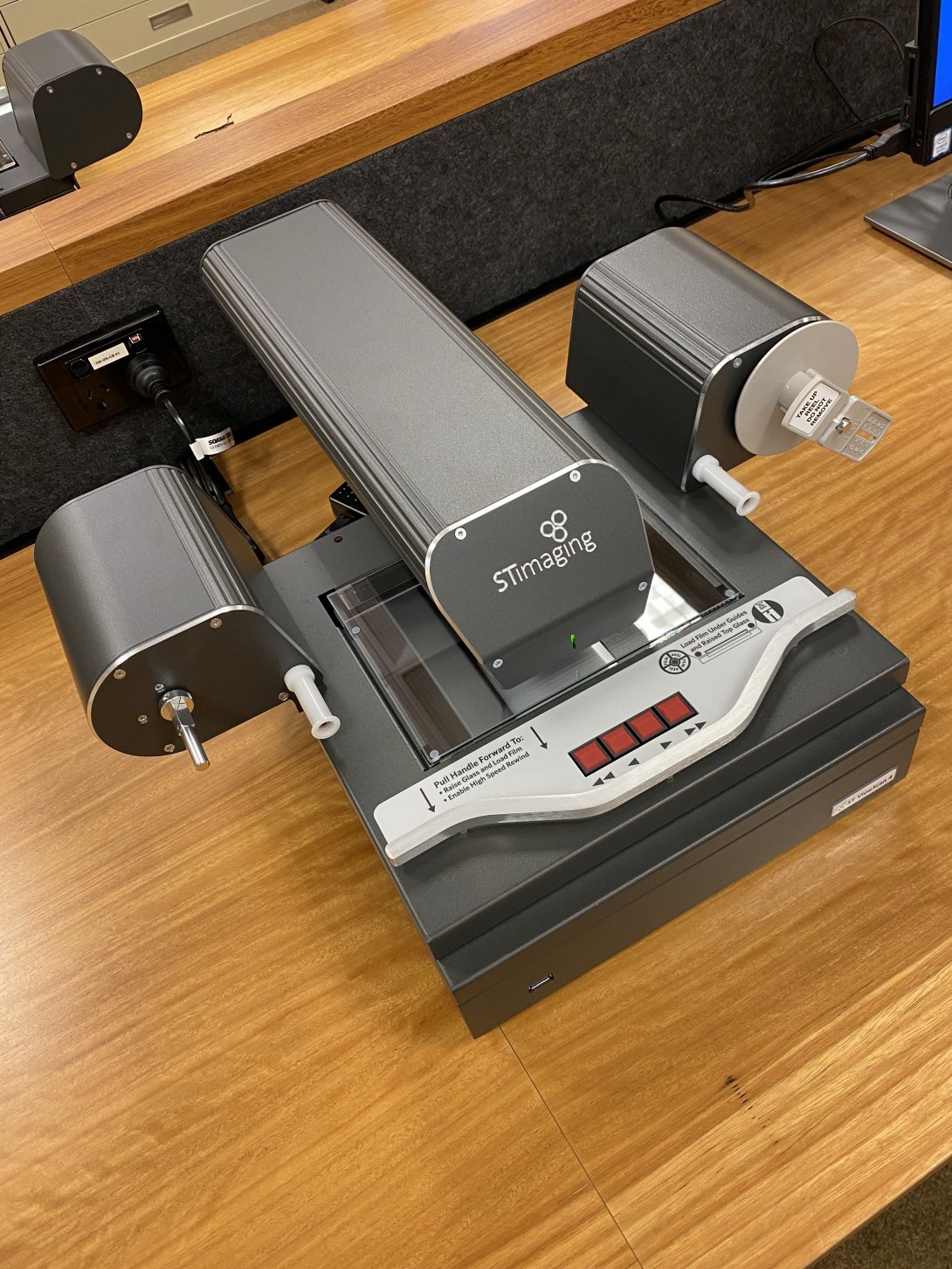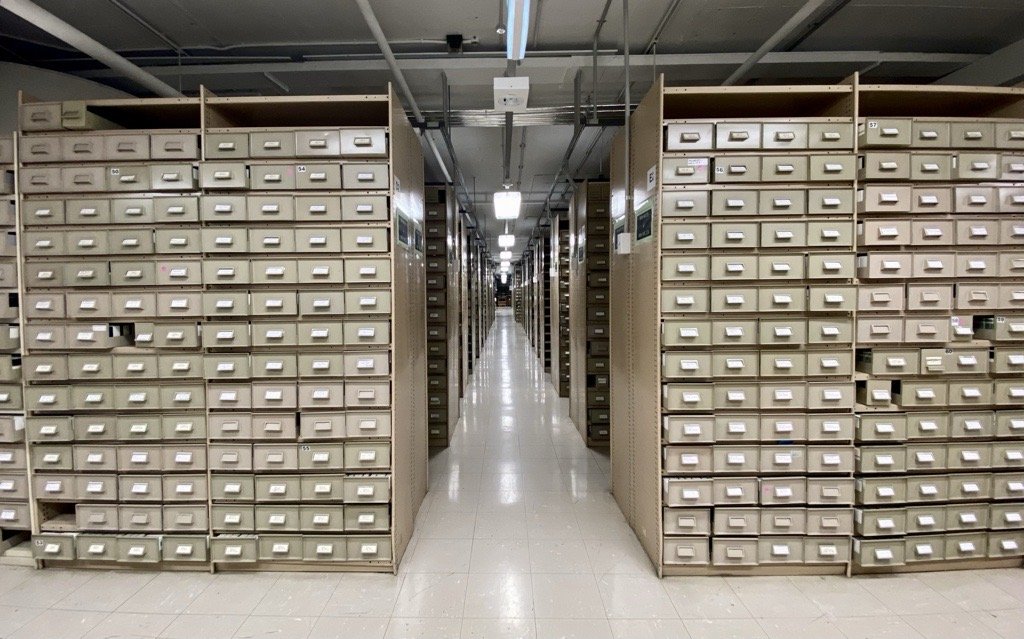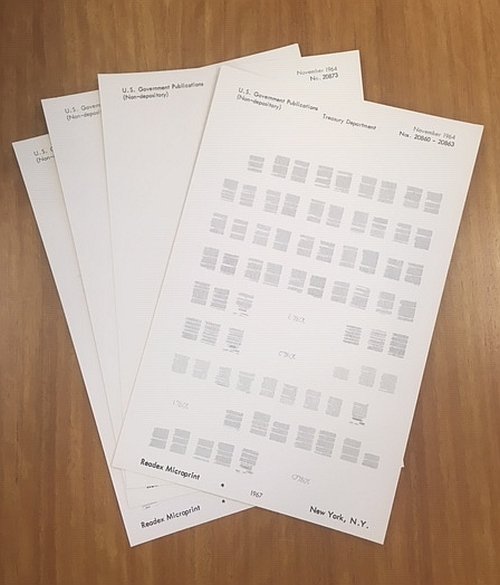If you heard a librarian say ‘micro fish’ you may be forgiven for thinking they were talking about tiny aquatic creatures. However, the ’fish’ they are referring to is actually microfiche. The Oxford Dictionary defines microfiche as a ‘flat piece of film, usually the size of a standard index card, containing microphotographs of a page of a book, periodical or catalogue'.
Microfiche is one format commonly used by family history researchers. The National Library of Australia offers a pool of resources presented on other formats such as microfilm, microprint or aperture card. Collectively, these formats are known as microform, and they can all be easily accessed using dedicated machines in the Newspapers and Family History Zone in the Main Reading Room.
Despite what people may think, microform is not dead, and the Library continues to receive collection items in these formats.

What is microfiche?
Microfiche, usually the size of postcards, has the appearance of a photonegative. The majority of microfiche held at the Library is in a negative format, the frames or pages being a black background with white text. The software attached to the machines will allow the user to change the image on the computer screen from a negative image to a positive image or vice versa. The microform machine will allow operators to navigate from page to page using the carriage handle at the front of the machine.
The Newspapers and Family History Zone holds Australian electoral rolls in microfiche format for each state and territory up to 2008. You may like to take a look at our research guide on Australian Electoral Rolls for more information on what we hold. One microfiche can capture up to 270 frames and in each individual frame can list 230 voters. That’s a lot of electoral rolls you can cast your eyes over!
One of our most requested microfiche series is the Australian Pamphlet Collection. This series has captured 7274 documents from the 19th and early 20th century on Australian subjects, by Australian authors or published in Australia. Many are unique, or very rare, so they are a great resource for historical research.
What is microfilm?
Microfilm looks like a miniature version of an old movie reel. The big advantage with this format is the capacity to store large amounts of information. Before the digital age, military and intelligence organisations used microfilm to communicate information and to preserve important documents during times of war.
Today newspaper preservation is the most common use for microfilm. Trove has digitised many Australian newspapers up until 1954 and afterwards (over 1000 titles and growing). Nevertheless, there are still newspapers that are only available in print or microfilm.

The Library holds many Australian and overseas newspapers in microfilm format with a collection spanning 13,607 linear metres. Microfilms at the Library will come in two sizes; 35mm reels and the narrower 16mm reels. Luckily, the machines in the reading room will allow you to view both sizes.
The software enables users to zoom in or out of an image or move forward or backwards using toolbar control buttons. We are often asked if the machines can be used to search and locate items on a reel such as a newspaper article, as can be done with an online database. Unfortunately, the answer to the question is no. Users will have to navigate their own way through the reel to find the item they are after. We do hold some printed indexes, which can help unlock the contents of our larger microform collections. Our friendly staff can help you access these indexes.
What is microprint?
Microprint is a flat opaque card that has a number of images on the one slide. Users can place the microprint card under the glass carrier and then change the software settings to view a microprint on the connected computer.
The microprint card is physically larger than a microfiche but the number of items in the collection is smaller than our microfiche holdings. The Library holds a total of 303.3 linear metres of microprint in our stacks.
Important collections held by the Library in microprint include the Landmarks of Science series. This collection traces the development of scientific principles over five centuries, starting from the 17th century and incorporating disciplines such as history, language, philosophy, astronomy, music and science.

What are aperture cards?
An aperture card is another type of microform. A negative film square inserted into a cardboard jacket is the most common. Documents captured on aperture could be building blueprints, photographs, artworks or maps. The majority of aperture cards held at the National Library of Australia contain maps. Popular map collections include the South Australian Hundred Maps collection and the Ordnance Survey of Ireland collection. The Library also holds the Aerial Photography Flight Diagrams for Victoria aperture cards of the flight diagrams for aerial photographs taken by Adastra for the Victorian government during the 1960s-70s. These include aerial photographs of highways, railways, racecourses, aerodromes and bushfires.
Microform is still in use today
Although microform may seem dated, it is still an effective way to preserve many collections held at the Library. Different microform formats can be viewed, scanned, emailed or saved by the user to USB using scanning software on the connected computer. The software has a range of features to improve the quality of the image on the screen.
Another microform question we are often asked is if the contents can be accessed online via the catalogue. Unfortunately placing a catalogue request does not allow you to access microform content offsite. If you cannot visit the Library, then placing a Copies Direct request may be an option for you.
There are always helpful staff on duty in the Newspapers and Family History Zone. If you need assistance, give them a wave, or you may like to drop them a line via our Ask a Librarian service for any collection enquiries